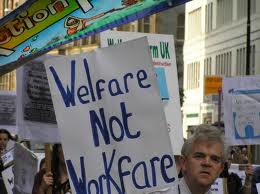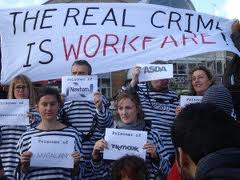Work-for-benefit schemes are becoming more prevalent in the English speaking world. Whilst forcing welfare recipients to work for welfare payments has always been popular in theory amongst conservatives, it has not been adopted much because it tends to cost more money in supervision and administration than it saves. One US study found that workfare, the American version of work-for-benefit, cost between $1000 and $7000 more per recipient than straight welfare.
 Nor is work-for-benefit designed to increase employment opportunities. Rather it is in part deterrent to those who would choose an ‘easy’ life on welfare, and in part designed to teach and promote a work ethic and work habits. Welfare recipients who are made to work for their benefit have to get up early, arrive at work on time, work with and for others, and acquire work skills.
Nor is work-for-benefit designed to increase employment opportunities. Rather it is in part deterrent to those who would choose an ‘easy’ life on welfare, and in part designed to teach and promote a work ethic and work habits. Welfare recipients who are made to work for their benefit have to get up early, arrive at work on time, work with and for others, and acquire work skills.
It is believed that welfare recipients who don’t work, not only lose the work ethic themselves but bring up children without a work ethic because their children lack a positive role model. Similarly, it is thought that requiring work for benefits is important to signal national priorities, goals and values. One advocate openly states: “The point is to enforce the work ethic. This is a long-term cultural offensive, not a budget-control program or an expression of compassion.”
As early as 1967 US legislation was amended to include work requirements for women receiving AFDC through the introduction of “workfare”. “Workfare” referred to a number of programmes aimed at getting welfare recipients back into the workforce. It included training programmes, work testing, subsidised child-care and job seeking assistance, as well as work-for-benefit.
Reference: Mickey Kaus, ‘The Work Ethic State: The only way to break the culture of poverty’, The New Republic (7 July 1986), p. 25; Keith Ogborn, ‘Workfare in America: An Initial Guide to the Debate’, (Woden, ACT: Department of Social Security, 1986), pp. 7-8.
Work-for-benefit was reintroduced in the 1980s under Ronald Reagan’s conservative government. Reagan enabled individual states to require welfare recipients, even sole parents of young children (over three years), to work in public service jobs to earn their payments. Congress repeatedly blocked attempts by the Reagan administration to make the scheme compulsory in all states but it was taken up by many states, although not in any comprehensive manner because of the cost.
 When Bill Clinton came to power in 1993 he promised to “end welfare as we know it.” The new US welfare reforms require that by the year 2002, fifty percent of those receiving benefits will be doing work or training in return. By the end of 1998 working for benefits, was a major component of welfare in New York, California, Ohio, Florida, Massachusetts, Wisconsin, New Jersey, and Colorado.
When Bill Clinton came to power in 1993 he promised to “end welfare as we know it.” The new US welfare reforms require that by the year 2002, fifty percent of those receiving benefits will be doing work or training in return. By the end of 1998 working for benefits, was a major component of welfare in New York, California, Ohio, Florida, Massachusetts, Wisconsin, New Jersey, and Colorado.
One of the most hailed experiments in work-for-benefit in the US was that of Wisconsin. Governor Tommy Thompson became a hero of the conservative think tanks and politicians championing welfare reform. In 1996 he introduced “Pay for Performance” which required a minimum number of hours of work or training in return for benefits. And in 1997 Thompson introduced “Wisconsin Works” (W2) which aims to abolish cash benefits altogether replacing them with payments for hours worked.
Whilst some of the thousands cut off the Wisconsin welfare roles found jobs, what became of the rest no-one really knows. And Thompson certainly doesn’t seem to want to know since he cut funding for tracking such people. Some may have moved in with relatives or moved to another state. The homeless shelters in Milwaukee have reported large increases in people using their facilities. The number of families in shelters in the winter of 1997 rose by 25 percent, according to the New York Times. Jason Turner, who has overseen the welfare ‘reforms’, claimed there was “no evidence” connecting “large numbers of new people in homeless shelters” with Wisconsin welfare reforms.
Reference: Deborah Cameron, ‘Land where pensions are as poisonous as grog’, Sydney Morning Herald, 8 May 1999; Senate Community Affairs Legislation Committee, ‘Social Security Legislation Amendment (Work for the Dole) Bill’, (Canberra: Parliament of the Commonwealth of Australia, 1997), Minority Report.
 In Australia, work-for-the-dole schemes were traditionally targeted at Aboriginal communities (about 10 percent of all Aboriginal people in Australia are in work-for-the-dole schemes). In 1997 the Howard Government introduced “Work for the Dole” for young people aged 18-24 who had been unemployed for more than six months. Its purpose was to “raise young unemployed people’s work ethic, through fostering appropriate work habits and attitudes, and improving self esteem.”
In Australia, work-for-the-dole schemes were traditionally targeted at Aboriginal communities (about 10 percent of all Aboriginal people in Australia are in work-for-the-dole schemes). In 1997 the Howard Government introduced “Work for the Dole” for young people aged 18-24 who had been unemployed for more than six months. Its purpose was to “raise young unemployed people’s work ethic, through fostering appropriate work habits and attitudes, and improving self esteem.”
Work habits expected to be fostered by the scheme include being able to work as part of a team and take directions from a supervisor as well as improving motivation and dependability. The Minister for Employment, Dr Kemp, said in a statement that showed the effect of media-reinforced prejudices about the unemployed, that the scheme would make it clear to young people “that the dole is not an alternative lifestyle”.
The government claimed “overwhelming community support” for the scheme and has been progressively expanding it. In July 1999 Work for the Dole was extended to cover 25-34 year olds at a cost of $100 million over four years. More than 40% of young people who work on such projects are conscripted—they don’t have a choice if they don’t want to lose part of their allowance. They work 2-2.5 days per week in return for the unemployment allowance plus $10 for expenses. As an adjunct to this scheme, in 1998 the government cut welfare benefits to unemployed people under 25 whose parents earned more than $23,400 and who couldn’t prove financial independence by having had a full-time job for at least 18 months or a part-time job for 2 years.
In Britain, the New Deal for Young People, which the Labour Government introduced after it came into office in 1997, gives young unemployed people four choices: working for an employer who would get a £60 per week subsidy, working for a voluntary sector organisation, working on an Environmental Taskforce or full-time education and training. The green paper on welfare reform made it clear there would be “no ‘fifth option’ of simply remaining on benefit” and those “who unreasonably refuse an offer or fail to take up a place will be sanctioned.”
 In 2011, the the UK tory government proposed that those receiving unemploymnet benefits who don't find a job after they have undertaken a work program will have be placed in a position where they work for 30 hours a week for 6 months. Businesses taking advantage of this involuntary workforce include McDonald's and Burger King. Waterstones and Sainsbury’s withdrew from the scheme due to adverse publicity.
In 2011, the the UK tory government proposed that those receiving unemploymnet benefits who don't find a job after they have undertaken a work program will have be placed in a position where they work for 30 hours a week for 6 months. Businesses taking advantage of this involuntary workforce include McDonald's and Burger King. Waterstones and Sainsbury’s withdrew from the scheme due to adverse publicity.
Work for benefit has also been increasing in Canada too. In June 1996 Ontario Works was launched. It requires welfare recipients to work up to 17 hours a week on community projects in return for their benefits. A key part of Ontario Premier Mike Harris’s election platform was his promise to make able-bodied welfare recipients either work or do training in return for the benefits and this was a key part of his election platform.